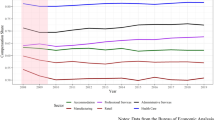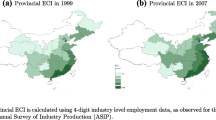Abstract
Rising inequality in the US, and resulting economic and wage stagnation, has been attributed to the growing productivity-compensation gap. Academics and policy makers have puzzled over the source of the gap since the 1970s. We hypothesize that the observed gap is misleading because productivity spillovers only partially translate into increased compensation. We analyze productivity spillovers with a spatial dimension, such that the industrial productivity of one state spills over to that of contiguous states. To do so, we employ a unique data set and spatial econometric techniques, including a spatial two-stage least squares instrumental variable approach and the spatially lagged X framework. The data set includes state-level industry panel data on employment, compensation, and gross industrial output for sixty-six industries within the forty-eight continental US states from 1998 to 2017. Once we account for productivity spillovers within industries, the gap between labor compensation and productivity narrows significantly.
Similar content being viewed by others
Availability of data and material
1997–2017 IO Snap data is available for purchase through the Regional Research Institute (RRI) at West Virginia University.
Code availability
Code is available at http://shishirshakya.github.io/. Code does not include data resources since those must be purchased through RRI.
Notes
IO-Snap is a user-friendly graphical-user-interface software that uses input-output data from the US national Supply and the Use tables, available from the US Bureau of Economic Analysis and the US Bureau of Labor Statistics (BLS). This software produces regionalized input-output accounts and coefficients for state economies (Regional Research Institute 2020) based on the Jackson (1998) input-output regionalization method and the Jackson and Court (2015) cross-hauling regionalization method.
We exclude Alaska and Hawaii from the analysis because they do not border any states.
Stansbury and Summers (2017) state that options such as the Annual Average Consumer Price Index Research Series (CPI-U-RS) and Personal Consumption Expenditures (PCE) yield similar results, but they prefer to deflate using CPI- U-RS rather than the PCE because CPI-U-RS deflates consumption of individuals/households; Lawrence (2016) favors PCE because it deflates consumption by nonprofits and some purchases of health care for individuals by government or employers.
National welfare data are maintained through the Center for Poverty Research at the University of Kentucky. These data contain annual measures of population, employment, unemployment, welfare, poverty, and politics.
The unionization database was created by Barry Hirsch of Georgia State University and David Macpherson of Trinity University. This data set provides information on private and public sector labor union memberships, coverage, and density compiled from monthly BLS reports. We use the total union membership within a state for the purposes of our sample.
µs and νt are states- and year-level fixed effects that absorb state characteristics and omitted effects common across all states that occurred during the period, respectively.
\(\Delta {\rm lnComp}_{{{\rm st}}} = \alpha + \gamma \Delta {\rm lnProd}_{{{\rm st}}} + \theta {\mathbf{W}}\Delta {\rm lnProd}_{{{\rm st}}} + {\mathbf{X}}_{st} \Gamma + \mu_{s} + \nu_{t} + e_{st}.\)
\(\Delta {\rm lnComp}_{{{\rm st}}} = \alpha + \rho {\mathbf{W}}\Delta {\rm lnComp}_{{{\rm st}}} + \gamma \Delta {\rm lnProd}_{{{\rm st}}} + \theta {\mathbf{W}}\Delta {\rm lnProd}_{{{\rm st}}} + {\mathbf{X}}_{{{\rm st}}} \Gamma + \mu_{{\rm s}} + \nu_{{\rm t}} + e_{{{\rm st}}}.\)
\(\Delta {\rm lnComp}_{{{\rm st}}} = \alpha + \gamma \Delta {\rm lnProd}_{{{\rm st}}} + \theta {\mathbf{W}}\Delta {\rm lnProd}_{{{\rm st}}} + {\mathbf{X}}_{{{\rm st}}} \Gamma + \mu_{{\rm s}} + \nu_{{\rm t}} + e_{{{\rm st}}} ,{\text{where}},u_{{{\rm st}}} = \lambda {\mathbf{W}}u_{{{\rm st}}} + e_{{{\rm st}}}.\)
References
Anselin L (2003) Spatial externalities, spatial multipliers, and spatial econometrics. Int Re Gional Sci Rev 26(2):153–166.
Arbu´es P, Ban˜os J, Mayor M, (2015) The spatial productivity of transportation infrastructure. Trans Port Res Part A 75:166–177.
Autor D, Salomons A (2018) Is automation labor-displacing? productivity growth, employment, and the labor share. Working Paper 24871, National Bureau of Economic Research
Barro RJ, Sala-i Martin X (1992) Convergence. J Polit Econ 100(2):223–251.
Ciarli T, Salgado E, Savona M (2018) Do low-wage workers benefit from productivity growth recovery? Working Paper 33/2018, ISI Growth. Doi:
Dosi G, Virgillito ME, Yu X (2020) The wage-productivity nexus in the world factory economy. World Dev 129:104875.
Elhorst JP (2010) Applied spatial econometrics: Raising the bar. Spat Econ Anal 5(1):9–28.
Faggio G, Silva O, Strange W (2017) Heterogeneous agglomeration. Rev Econ Stat 99(1):80–94.
Fischer M, Scherngell T, Reismann M (2009a) Knowledge spillovers and total factor productivity. evi- dence using a spatial panel data model. Geogr Anal 41(2):204–220
Fischer MM, Scherngell T, Jansenberger E (2009b) Geographic localisation of knowledge spillovers: evidence from high-tech patent citations in Europe. Ann Region Sci 43:839–858.
Frank MW (2009) Inequality and growth in the united states: Evidence from a new state-level panel of income inequality measures. Econ Inq 47(1):55–68.
Gallardo R, Whitacre B, Kumar I, Upendram S (2021) Broadband metrics and job productivity: a look at county-level data. Ann Reg Sci 66:161–184.
Garofalo G, Malhotra D (1989) Intertemporal and interspatial productivity differentials in U.S. manu- facturing. Ann Reg Sci 23:121–136.
Giroud X, Lenzu S, Maingi Q, Mueller H (2021) Propagation and amplification of local productivity spillovers. Working Paper 29084, National Bureau of Economic Research.
Hirsch BT, MacPherson DA (2003) Union membership and coverage database from the current popula- tion survey: Note. Ind Labor Relat Rev 56(2):349–354.
Hornbeck R, Moretti E (2020) Estimating who benefits from productivity growth: Local and distant effects of city tfp shocks on wages, rents, and inequality. Discussion Paper 12277, Institute of Labor Economics
Jackson R (1998) Regionalizing national commodity-by-industry accounts. Econ Syst Res 10(3):223–238.
Jackson R, Court C (2015) Toward consistent cross-hauling estimation for input-output regionalization. Working Paper 2015–01, Regional Research Institute, West Virginia University
Kelejian HH, Prucha IR (1998) A generalized spatial two-stage least squares procedure for estimating a spatial autoregressive model with autoregressive disturbances. J Real Estate Finance Econ 17(1):99–121.
Lawrence RZ (2016) Does Productivity Still Determine Worker Compensation? Domestic and Inter- national Evidence. Washington, D.C.: American Enterprise Institute Press, URL https://www.aei. org/wp-content/uploads/2016/07/The-US-Labor-Market-7–1-complete.pdf
LeSage J, Pace RK (2009) Introduction to Spatial Econometrics. Boca Raton: Taylor & Francis Group, URL https://www.taylorfrancis.com/books/9780429138089
LeSage JP (2014) What regional scientists need to know about spatial econometrics. Rev Region Stud 44(1):13–32.
LeSage JP (2015) Software for bayesian cross section and panel spatial model comparison. J Geogr Syst 17(4):297–310
Mallick R, Carayannis EG (1994) Regional economic convergence in mexico: An analysis by industry. Growth Chang 25(3):325–334.
McCombie JS (1988) A synoptic view of regional growth and unemployment: I—the neoclassical theory. Urban Studies 25(4):267–281.
Meyerson H (2014) How to raise americans’ wages—the american prospect. URL https://prospect.org/power/raise-americans-wages/
Mishel L, Bivens J, Gould E, Shierholz H (2012) The State of Working America, 12th edn. Ithaca: Cornell University Press, URL: http://www.jstor.org/stable/
Regional Research Institute (2020) Input-Output - State and National Analysis Program. IO-SNAP, Software, Regional Research Institute, West Virginia University, Regional Research Institute, West Virginia University, URL: https://www.io-snap.com, accessed: 2020–11–02
Rosenthal S, Strange W (2001) The determinants of agglomeration. J Urban Econ 50(2):191–229.
S M (2013) Inequality: A defining issue, for poor people. URL:https://www.economist.com/ democracy-in-america/2013/12/16/a-defining-issue-for-poor-people
Smith DM (1975) Neoclassical growth models and regional growth in the U.S. Journal of Regional Science 15(2):165–182
Smith N (2017) Workers get nothing when they produce more? wrong. URL https://www.bloomberg. com/opinion/articles/2017–12–04/workers-get-nothing-when-they-produce-more-wrong
Staiger D, Stock JH (1997) Instrumental variables regression with weak instruments. Econometrica 65(3):557–586.
Stansbury A, Summers LH (2020) The declining worker power hypothesis: An explanation for the recent evolution of the american economy. Working Paper 27193, National Bureau of Economic Research
Stansbury AM, Summers LH (2017) Productivity and pay: Is the link broken? Working Paper 24165, National Bureau of Economic Research
Tsvetkova A, Ahrend R, Mrtins JO, Lembcke AC, Knutsson P, Jong D, Terzidis N (2020) The spatial dimension of productivity: Connecting the dots across industries, firms and places. Working Paper 2020/01, OECD Regional Development Working Papers
University of Kentucky Center for Poverty Research (2019) UKCPR National Welfare Data, 1980–2017. URL: http://ukcpr.org/resources/national-welfare-data
Vega SH, Elhorst JP (2015) The SLX model. J Reg Sci 55(3):339–363.
White GB (2015) Why the gap between worker pay and productivity is so problematic. URL https://www.theatlantic.com/business/archive/2015/02/ why-the-gap-between-worker-pay-and-productivity-is-so-problematic/385931/
Acknowledgements
We would like to thank Akshiti Modi, Randall Jackson, and Roger Bivand.
Funding
No funding was obtained for this research.
Author information
Authors and Affiliations
Corresponding author
Ethics declarations
Conflict of interest
Authors must disclose all relationships or interests that could have direct or potential influence or impart bias on the work: The authors declare that they have no conflict of interest.
Ethics approval
Not applicable.
Consent to participate
Not applicable.
Consent for publication
Not applicable.
Additional information
Publisher's Note
Springer Nature remains neutral with regard to jurisdictional claims in published maps and institutional affiliations.
Rights and permissions
About this article
Cite this article
Shakya, S., Plemmons, A. & Sayago-Gomez, J.T. Spatial spillovers and the productivity-compensation gap in the United States. Ann Reg Sci 68, 669–689 (2022). https://doi.org/10.1007/s00168-021-01099-2
Received:
Accepted:
Published:
Issue Date:
DOI: https://doi.org/10.1007/s00168-021-01099-2




